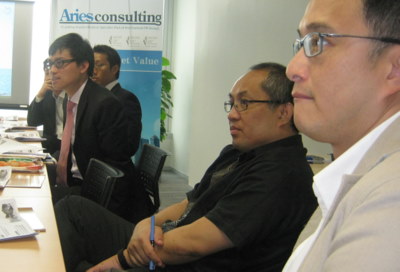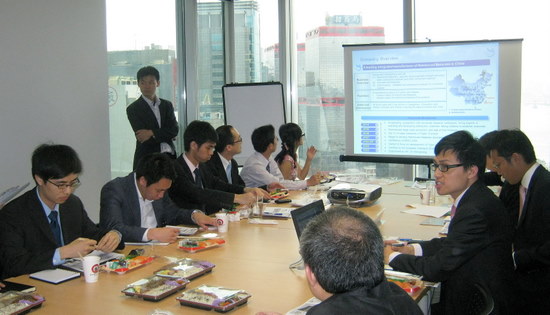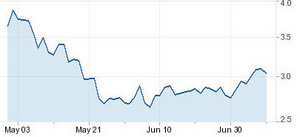
SIJIA GROUP Co Ltd (HK: 1863), a Fujian province-based firm producing polymer processed high strength polyester fabric composite materials and other reinforced composite materials for everything from biogas tanks and membrane buildings to waterslides and inflatable boats, has the biggest market share in China for its sector.
But the figure is still only in the single digits.
On Wednesday, Sijia issued a positive profit alert, saying it expected to record a “significant increase” in profit for the six months ended June 30, 2010 as compared to that for the same period in 2009, mainly attributable to the increase in sales of reinforced materials and end products.
Aries Consulting yesterday got management, analysts and journalists together to hear how the Hong Kong-listed firm got to be number one, and how they plan to expand their share of the market.
It was Sijia’s first such stepping out party as a public firm after having raised some 700 mln hkd in an April 29 listing, and the baker’s dozen of attendees, including investors from firms such as MCL, Capital IQ, Finansa, AmCap and China Merchants Securities were eager to hear how China’s top firm for reinforced polymer composite materials was planning on capturing more market share.

Getting there was half the battle as Hong Kong was facing outer band torrential downpours from Typhoon Chanthu which had just skirted the Special Administrative Region that day, perhaps a fitting setting for Sijia, China’s top producer of the material used in inflatable boats.
High and dry far above the deluge in a conference room overlooking Victoria Harbor, Sijia’s CFO Mr. Alvin Chan said that due to robust expected demand in the sector and recent inability to meet a deluge of orders, the company was making the investments now to meet anticipated demand down the road.
"China’s market for reinforced materials is expected to reach 20.4 bln yuan by 2014, an average growth of 25.3% per year. More importantly, the end-product market (for products like rubber dinghies, waterslides, and biogas tanks) is seen growing 36.4% annually over the same period, much faster than in the US (6.7%) and Europe (5.0%),” Mr. Chan said.
|
|||||||||||||||||
And what concrete steps was Sijia taking to keep pace with this attractive growth prospect in China?
"Last year, we raised our materials capacity to 87 mln square meters, and our end-product capacity to 580,000 units, which contributed 570 mln yuan in revenue. We are boosting the capacity by 50% annually over the next three years, at least,” he said.
All Eyes on China Market
Investors were impressed with the company’s extremely ambitious production capacity growth plans, all based out of their two plants in eastern China’s Fujian province in the cities of Fuzhou and Xiamen.
But many had questions for Sijia regarding details of the Hong Kong-listed firm’s optimism for the market, and upon what it was based.
"We are currently No.1 in China for reinforced materials, but our market share is only 3.5% as the industry is still quite fragmented. Therefore, we are confident that there is considerable room for improvement. Already, we have boosted our market share in China for inflatable products (eg: dinghies, slides, biogas tanks) to 30%,” Mr. Chan said.

Investors were also struck by the company’s Cost of Sales Structure, with raw materials’ costs comprising an overwhelming 96.4% of the total last year, while labor was No.2 on the list at just 1.2%.
"Our industry is not labor intensive. In fact, labor costs were 2.6% of the total in 2007 and have declined steadily since then. We are a highly automated industry, and therefore raw materials (additives: 53.9%, fabrics: 24.2%, polymers: 21.9%) are our biggest cost burden,” he said.
Did a fragmented market with many small players mean that Sijia was planning on a shopping spree to consolidate its position through acquisitions?
"We have always relied on organic growth and have no plans for M&As at this point. We have the technology necessary, and a lot of our domestic peers stick to conventional materials and do not expand into reinforced materials. That is one of our core strengths,” he added.
In fact, Sijia enjoyed a long list of competitive strengths that helped the Fujian province-based manufacturer stand atop the domestic market.

"Our industry is experiencing tremendous market potential, and as a Chinese firm we enjoy very favorable government policies, namely direct development and procurement subsidies from the PRC government.”
Sijia’s reinforced materials are also used to manufacture biogas tanks, with the sector expected to enjoy some 23 bln yuan in direct subsidies from Beijing by 2014.
"We only entered the fast-growth (biogas tank) segment in the fourth quarter of 2009, so we see tremendous room for growth here,” he said.
Mr. Chan went on to say the company had a “very strong R&D capability” and commitment to product innovation, with a 31 person-strong engineering team at its Xiamen research facility.
"We have exclusive research sharing agreements with professors at Fuzhou University, Tsinghua University and Tianjin Polytechnic University with the shared goal of striving to self-develop and self-assemble more products to reduce import reliance and therefore cut costs considerably,” he said.
This commitment to research has already won Sijia 49 registered patents with 21 more in application.
|
|||||||||||||||||
It has also helped the company be the go-to producer for finished products with overseas labels.
"Most local companies cannot meet stringent OEM standards. We can. This is our strength,” Mr. Chan said.
The company will announce its first interim results as a listed firm on August 25, and if Sijia’s bulging order book is any indication, the Hong Kong-listed firm should have a very strong reporting period.
Read about a Singapore-based firm also with plants in Fujian expecting rapid growth:
SINOMEM: Achieved 50%, 90% market share in pharma, dyestuff industries







